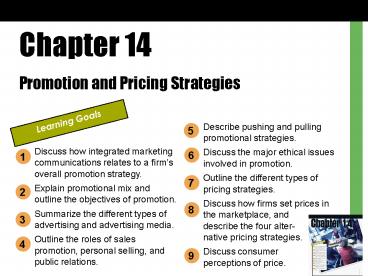Promotion and Pricing Strategies - PowerPoint PPT Presentation
1 / 17
Title:
Promotion and Pricing Strategies
Description:
Chapter 14 Promotion and Pricing Strategies Learning Goals Describe pushing and pulling promotional strategies. Discuss the major ethical issues involved in promotion. – PowerPoint PPT presentation
Number of Views:707
Avg rating:3.0/5.0
Title: Promotion and Pricing Strategies
1
Chapter 14 Promotion and Pricing Strategies
Learning Goals
Describe pushing and pulling promotional
strategies. Discuss the major ethical issues
involved in promotion. Outline the different
types of pricing strategies. Discuss how firms
set prices in the marketplace, and describe the
four alter-native pricing strategies. Discuss
consumer perceptions of price.
5
Discuss how integrated marketing communications
relates to a firms overall promotion
strategy. Explain promotional mix and outline the
objectives of promotion. Summarize the different
types of advertising and advertising
media. Outline the roles of sales promotion,
personal selling, and public relations.
6
1
7
2
8
3
4
9
2
Promotion The function of informing, persuading,
and influencing a purchase decision. Integrated
marketing communications (IMC) Coordination of
all promotional activitiesmedia advertising,
direct mail, personal selling, sales promotion,
and public relationsto produce a unified
customer-focused message. INTEGRATED MARKETING
COMMUNICATIONS Must take a broad view and plan
for all form of customer contact. Create
unified personality and message for the good,
service, or brand. Elements include personal
selling, advertising, sales promotion,
publicity, and public relations.
3
THE PROMOTIONAL MIX Promotional mix Combination
of personal and nonpersonal selling techniques
designed to achieve promotional
objectives. Personal selling Interpersonal
promotional process involving a sellers
face-to-face presentation to a prospective
buyer. Nonpersonal selling Advertising, sales
promotion, direct marketing, and public relations.
4
Objectives of Promotional Strategy
5
Promotional Planning Product placement
Marketers pay placement fees to have their
products showcased in various media, ranging from
newspapers and magazines to television and
movies. Guerilla marketing Innovative, low-cost
marketing efforts designed to get consumers
attention in unusual ways.
6
ADVERTISING Advertising Paid nonpersonal
communication delivered through various media and
designed to inform, persuade, or remind members
of a particular audience. Types of Advertising
Product advertising, institutional advertising,
cause advertising Advertising and the Product
Life Cycle Informative advertising Build
initial demand for a product. Persuasive
advertising Improve the competitive status of a
product. Reminder-oriented advertising Maintain
awareness of the importance and usefulness of a
product.
7
Advertising Media All media offer advantages
and disadvantages
8
SALES PROMOTION Sales promotion Nonpersonal
marketing activities other than advertising,
personal selling, and public relations that
stimulate consumer purchasing and dealer
effectiveness.
9
Consumer-Oriented Promotions Premiums, Coupons,
Rebates, Samples Two of every five promotion
dollars are spent on premiums, items given free
or at reduced price with the purchase of another
product. Coupons attract new customers but
focus on price rather than brand
loyalty. Rebates increase purchase rates,
promote multiple purchases, and reward product
users. Three of every four consumers who
receive a sample will try it. Games, Contest, and
Sweepstakes Often used to introduce new goods
and attract new customers. Subject to legal
restrictions. Specialty Advertising Gift of
useful merchandise carrying the name, logo, or
slogan of an organization.
10
PERSONAL SELLING A person-to-person promotional
presentation to a potential buyer. Usually used
under four conditions Customers are
relatively few in number and geographically
concentrated. The product is technically
complex, involves trade-ins, and requires special
handling. The product carries a relatively
high price. It moves through
direct-distribution channels. Example Selling
to the government or military.
11
The Sales Process
12
Public Relations Public relations Public
organizations communications and relationships
with its various audience. Helps a firm
establish awareness of goods and services and
builds a positive image of them. Publicity Publici
ty Stimulation of demand for a good, service,
place, idea, person, or organization by
disseminating news or obtaining favorable unpaid
media presentations. Good publicity can promote
a firms positive image Negative publicity can
cause problems.
13
PROMOTIONAL STRATEGY Pushing and Pulling
Strategies Pushing strategy Relies on personal
selling to market an item to wholesalers and
retailers in a companys distribution channels.
Companies promote the product to members of
the marketing channel, not to end users.
Pulling strategy Promote a product by
generating consumer demand for it, primarily
through advertising and sales promotion appeals.
Potential buyers will request that their
suppliersretailers or local distributorscarry
the product, thereby pulling it through the
distribution channel. Most marketing
situations require combinations of pushing and
pulling strategies, although the primary emphasis
can vary.
14
ETHICS IN PROMOTION Puffery and
Deception Puffery Exaggeration about the
benefits or superiority of a product.
Deception Deliberately making promises that
are untrue, such as guaranteed weight loss in
five days, get-rich-quick schemes for would-be
entrepreneurs, or promised return on
investments. Promotion to Children and Teens
Children and teens have enormous purchasing power
but cannot analyze advertising messages.
Promotion in Public Schools and on College
Campuses Schools earn income from in-school
advertising, but it is generating backlash.
15
PRICING OBJECTIVES IN THE MARKETING MIX Price
Exchange value of a good or service.
16
PRICING STRATEGIES Pricing is influenced by
people in different areas of a company. Price
Determination in Practice Cost-based pricing
Adding a percentage (markup) to the base cost of
a product to cover overhead costs and generate
profits. Actual markup used varies by such
factors as brand image and type of
store. Example Typical clothing markup by
retailers is double the wholesaler
price. Breakeven Analysis Breakeven analysis
Pricing technique used to determine the minimum
sales volume a product must generate at a certain
price level to cover all costs.
17
CONSUMER PERCEPTIONS OF PRICE Price-Quality
Relationships Consumers perceptions of quality
closely tied to price. High price prestige
and higher quality. Low price less prestige
and lower quality. Odd Pricing Setting prices
in uneven amounts or amounts that sound less than
they really are. Example 1.99 or
299. Also used as a signal a product is on
sale.































